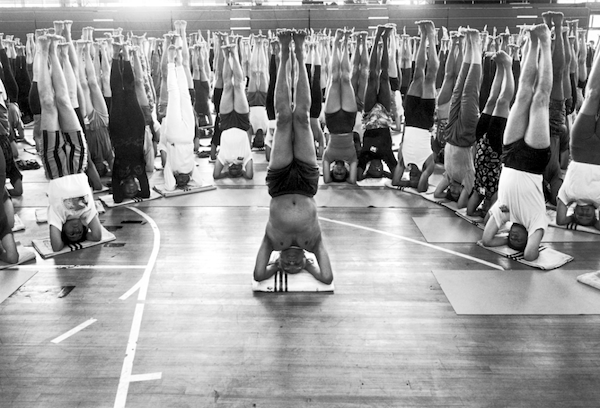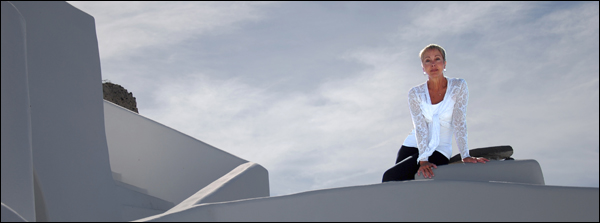The One-Legged Yogini
“Iyengar Yoga master-teacher, Kofi Busia, writes: ‘Health is not, and cannot be, an individual affair. It is a community—indeed, a cosmic—affair. Individuation is the root cause of all suffering. A community, even a yoga community, sickens when its individual members do not extend the bonds of unity to one another through the exercise awareness and purusha dharma [the Soul’s religious duty]. The community sickens when its members fail to alleviate their mutual suffering through a benevolent ‘knowing’ of the truth that stands behind each other’s existence.”—Elizabeth Boleman-Herring
By Way of Being
By Elizabeth Boleman-Herring

“Although thirty spokes meet at the hub,/it is the empty space at the center/Which makes the cart move.”―Laozi
Author’s Note: This column was first published in August of 2009. It is dedicated, always, to Marian and Susan .
 PENDLETON South Carolina—(Weekly Hubris)—January 2019— After an almost-30-year relationship with Yoga, I still pride myself on many things, and priding oneself on many things is like walking through a completely darkened room where there is a lot of small, sharp-cornered furniture located precisely at shin-height.
PENDLETON South Carolina—(Weekly Hubris)—January 2019— After an almost-30-year relationship with Yoga, I still pride myself on many things, and priding oneself on many things is like walking through a completely darkened room where there is a lot of small, sharp-cornered furniture located precisely at shin-height.
One of the things I habitually pride myself on is my almost-spook-like intuition about others’ intentions/abilities/challenges. I like to think I “read” people pretty well. (Ahh, you might say: then how in the world did she marry two closeted homosexuals?) Pride goeth before a fall. Many prides goeth before many falls . . . and I have the bruises on my shins to prove it.
But you would think that, as an Iyengar-style Yoga teacher of two (mere) years’ standing, I might at least notice if a one-legged Yogini (female Yoga student) “walked” into my classroom.
Reader, I did not notice.
And, adding insult to injury, I kept correcting this student (whom I’ll call “Ramamani,” as she’s from the Sub-Continent) for failing to straighten her right foot, spread her right toes, straighten completely her right knee. Ramamani took all this direction in stride (literally), and forged ahead through that evening’s sequence of standing asanas, pretty much move for move with the rest of the class. I thought to myself: “She’s a newish Iyengar student who’s obviously done some other variety of Yoga before. She’s probably just having an off-night.”
As I do with all new students, I did not focus my high beams on this diminutive Indian woman teenager, really. I just kept her close and adjusted her gently, and only very occasionally, through the one-and-a-half-hour-long class.
I’ve been taught to ask new students if they have injuries or disabilities to “declare before class begins, but have given up the the practice in my own teaching as “too invasive.” Even asking, “Are there any physical problems anyone would like to tell me about before we begin?” seems to me too intrusive a query. I have students who are undergoing chemotherapy, students with herniated vertebral disks, students whose ankles comprise, largely, bits of titanium, students with about as much proprioception (knowledge of where their body parts are at any given moment) as a chunk of feldspar.
If I had to answer that “Where are you broken?” question, myself, I’d have to “admit” I have a dickey mitral valve, suffer from major depression, have lupus, hypothyroidism, and every sleep disorder known to science: I don’t really sleep; I’m simply awake for about twelve hours between nightmares.”
But a one-legged Yogini, you’d think I’d notice.
Ramamani is in her late teens and she is a survivor. At least, most of her survived her childhood illness. The muscles of her right leg, however, in their entirety, have moved beyond that leg’s control. But the woman is such a marvel, and so adept at illusion, that she can go up into Shoulder-Stand (Salamba Sarvangasana) “carrying” her right foot (and leg) up, pinched between her left toes.
When you have 18 students in a gym Yoga class, and half of them are beginners, you feel like a mother hen with chicks going off in eleven unruly directions, so Ramamani got into Shoulder-Stand without my really seeing her do it. It’s only when I looked over at her—and her idiosyncratic set-up of bolster, mat, and blankets, which I had cavalierly chalked up to “another time/another teacher’s style”—that I noticed the left foot’s toes’ hanging on for dear life to the lifeless right foot’s toes.
As a Yoga teacher, it is hard to explain the emotions that transfixed me at that moment, and in what order they coursed through me. Shame? Guilt? (Oh yes, I was brought up Presbyterian!) But, then, awe, pride, astonishment, curiosity, love.
The list goes on, still.
After class, Ramamani duly filled out my New Student Form and, at the very foot of the page, where I ask students to declare their challenges, she wrote one simple word: Polio. Born in the early 1990s, this perfectly beautiful young woman had somehow escaped being inoculated; had somehow contracted polio; and then had somehow landed in New Jersey: a “one-legged,” practicing Yogini .
One of my Iyengar teachers once said of me that I would take on even students who couldn’t walk. I’m not at all sure that he said this of me with unalloyed kindness in his heart. But one thing is certain: I’ve taught Ramamani nothing, but her classmates and I have skipped a grade or two just for having her with us.
The second time I saw her, I arrived early, as usual, carrying my usual six mats or so, plus a notebook, purse, bottle of Gatorade-2, and who knows what else. All my years living (car-less) in Greece have convinced me that, as long as I can hang it off my body somewhere, I can
carry it.
Ramamani was there, early as well (like the good Yogini she is), and she rushed forward, on one leg, as it were, to “help” me lighten my load. Again . . . that rush of emotions. “Jesus, Woman, you’ve got one leg! Have you noticed that fact?!”
I let her take the mats from me. I am her “teacher”: it is what she must do, as my student. I’ve not yet had much time to talk with her, one-on-one. I teach in gyms, for heaven’s sake, not in ashrams, not in Pune, India, not in the beautiful Iyengar Yoga Association digs in Manhattan. But in little gyms in New Jersey, one of whose owners has seen fit to build a Yoga room. (“If you build it, they will come,” I said.)
But I did kneel down with Ramamani at the end of our last class together and tell her I did not want to hurt her, to have her hurt, on my watch. I asked how I could help; if I could help. She told me her pain receptors in that “dead” leg are all functional, and tell her when she’s pushing too hard. But she also told me that she’s been doing Yoga all her life, and that, furthermore, she was there to learn; to progress. She felt I would help her progress.
Reader, I was speechless. I’ve been an Iyengar devotee for only six years, teaching for only two, and am still working my way through the process of accreditation and certification (which, in the Iyengar system, is not “lifelong,” but “multiple-lives-long”). I told Ramanani it was far more likely that I’d learn from her than vice-versa.
Before the next class, I contacted my two longtime student-assistants—one, in her 40s; one, in her 60s—and asked them quietly to keep a weather eye on Ramamani when I’m not right there to support her right leg, or she’s in Headstand (Sirsasana) and “needs a leg down.” But I rather think the three of us will be on very light duty with her.
Iyengar Yoga master-teacher, Kofi Busia,* writes: “Health is not, and cannot be, an individual affair. It is a community—indeed, a cosmic—affair. Individuation is the root cause of all suffering. A community, even a yoga community, sickens when its individual members do not extend the bonds of unity to one another through the exercise awareness and purusha dharma [the Soul’s religious duty]. The community sickens when its members fail to alleviate their mutual suffering through a benevolent ‘knowing’ of the truth that stands behind each other’s existence. Dharma [duty, virtue] insists that human-heartedness, benevolence, and compassion be a full part of wellness, for that is the way that suffering ends and the absolute is restored.”
So, now, in the gym’s little mixed-level classes, where students with greater and lesser abilities, greater and lesser challenges, all mix together, every day of the week to study the asanas in a sort of “one-room schoolhouse,” we are one leg short, and one Ramamani richer.
*Iyengar: The Yoga Master, edited by Kofi Busia, Shambhala Publications, Inc., 2007.
![]()
To order Elizabeth Boleman-Herring’s memoir and/or her erotic novel, click on the book covers below:



2 Comments
Dora Seeley
Hi Elizabeth,
Gerry and I just came home from yoga with our Iyengar teacher Karyl Tych here in Myrtle Beach. For some reason my computer opened to my old e- mail address which I have not used for several years now just to see your e-mail.
It looks like you are back in SC, is that right? In Pendleton?
I’d love to hear from you. My address I am emailing from is seeleydora@gmail.com
Curious how life is treating you.
I am happy here in MB with my wonderful husband and Meher Baba. We are leading a quiet life but full and never boring.
love,
Dori
Diana
A lovely story. I’d forgotten it but certainly inspiring to this old not quite yogini who’s enjoying a class for oldies.